|
|
About
 
Embracing the Jade Green Of Jinshan
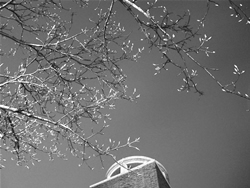
The emergence of Dharma Drum Mountain was both incidental and certain. It was incidental because it seemed to come from the power of thousands persistently chanting the Great Compassion Mantra, turning the urgent wish into reality. It was a certainty because once the initial dream was realized the development of educational, cultural, and charitable activities, as well as the facilities, have progressed like powerful waves.
Eight Years in Search for Land
First Blossom the of Wax Apple Trees
A visitor to Nung Chan Monastery will enjoy looking at the wax apple trees surrounding the monastery, especially in early summer when the branches are heavy with fruit and cicadas sing their endless songs. The eager cicadas and wax apple trees are singing the same song: "Summer is already here!" At best, wax apple trees bear fruit in three to five years and for late bloomers, in seven to eight years. The trees at Nung Chan are very late bloomers, for they took over ten years to produce their first crop. It is said that the trees first blossomed and became laden with fruit in the summer of 1989, just as Nung Chan Monastery's quest for the perfect land was fulfilled that spring.
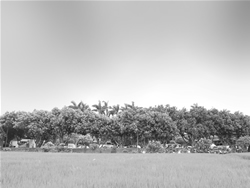 Finding a Land
Finding a Land
The monastery had been searching for land close to the hilly suburbs of the city on which to build a place for advanced Buddhist studies. The Chung-Hwa Institute of Buddhist Studies (CHIBS), founded in 1955, was located inside the Chung-Hwa Institute of Buddhist Culture (CHIBC). A good start for teaching the Dharma independently, it was still a temporary arrangement. Over the years the building was shared by both organizations, it became inadequate as the number of students, faculty, and staff increased. The need for a new place made the search for land even more urgent. In March of 1989, Taipei City Government rezoned the Guandu Plain subdivision, where the monastery was, into a low-density residential area. The government was expected to purchase half of monastery's mere 2.5 acres. The Sangha and its supporters grew increasingly anxious.
On a Spring Night: The Great Compassion Mantra Chanted by a Thousand People
The evening of March 25, 1989 was a refreshing one. It was springtime near the Tomb Sweeping Day on April 5. The rainy season had not started but the weather became warmer. The monastery was holding the usual Buddha's name recitation, with twice the usual number of one thousand crowding the main hall.

Before the practice started, devotee Xiong Qingliang told Master Sheng Yen that the core staff of the chanting society would like to chant the Great Compassion Mantra a hundred and eight times to pray for favorable conditions in finding land. Master Sheng Yen considered it feasible and thought it would generate more mind power if the whole memlers of the society chanted together. Master Sheng Yen then led all the members together with the disciples, all kneeling, to chant the Great Compassion Mantra twenty-one times in the Grand Hall in Nung Chan Monastery. In that clear spring night, the sound of Gnanyin's Great, Perfect, Unobstructed, Compassionate Mantra filled the sky above the monastery. After that night miraculous things started to happen.
After the chanting, a man said to one of the receptionists as if congratulating, "Your land is found!" On March 27, Lin Xianzheng, a long supporter of CHIBS, also the owner of the Longmen Hotel in Xinbeitou, had a vision that morning. That led him to the Fo'en Monastery where he believed he would receive omens regarding the land.
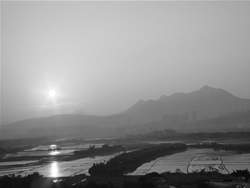
Most of Mr. Lin's visions had become real in the past, so with firm conviction he went to the Foen Monastery where Abbot Ven. Tongdu introduced Ven. Quandu to Mr. Lin. Ven. Quandu confirmed that there was such a piece of land just waiting for the right buyer.
Finding Land in Jinshan
In 1989 an opportunity to find land in Jinshan of Taipei County came up. Lin immediately informed Prof. Fang Ningshu, a director of CHIBS, and invited him to check out the land together next morning. After seeing it, both liked it very much but Master Sheng Yen had to approve it. As a matter of fact the Master had looked at land in Jinshan before but was never pleased, so he was not very keen to take a look at this land. Had it not been for the sincere recommendation from Lin and Prof. Fang, the issue might have ended there. On March 28, Liao Jinrong answered a call to the CHIBC from Lin and a little later, Lin and. Fang showed up to persuade Master Sheng Yen to look at the land.
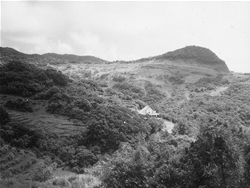
The four got on the Yangjin Highway to Jinshan, with Liao driving. She had never been to Jinshan and was not familiar with the roads but after they passed Yangming Mountain, Prof. Fang suddenly pointed out, "From now on, we just need to follow the yellow line and it should be right!" After an hour the Guanyin Temple in Jinshan began to appear.
The site is close to the north coast but the ocean is not visible from there and winds from the ocean cannot reach there. It is shielded by hills from the left, right, and behind. With its surroundings, the area is shaped like an armchair, the property being the seat. It looks out on the plain where the town of Jinshan is, with the far side of the plain being the overlapping mountains of the Wanli town. It was as if the mountains were paying homage to this place. Master Sheng Yen was very satisfied and commented that as a place for practice, it was as perfect as the pure lands of the Buddhas. The more Master Sheng Yen looked at it, the more he liked it.

In a few days, urged by Lin Xianzheng, Prof. Fang Ningshu, and Yang Zheng, then chairman of the Dharma Upholders Council of CHIBS, and other supporters, Master Sheng Yen made a bold move. At the Fo'en Monastery he signed the contract with the representative of the owners of the land, Ven. Quandu, to acquire the 43.2-acre property. Ven. Quandu and Li Zhaonan donated their share of the land. The rest of the land cost over NT$ 70million, due in three months.
Ven. Quandu Becomes One of the Honorable Members of the Board of Directors
Nung Chan Monastery's several-year search for land was fulfilled in 1989, as did the wish of Ven. Quandu, who went by the family name of Fan before becoming a monk. As a former chairperson of the Branch of Taipei Taichi Association, he and his friends purchased the land in Jinshan a long time ago and he became its main manager. Amid mountains, the place offers a beautiful view. Originally intended to be a cemetery, the land would have been divided and sold as burial plots. However, someone pointed out the locale was a lotus land, a pure land for spiritual practice and to be used any other way would be wasteful.
So, Ven. Quandu changed the land's purpose and built the 3,600 square-foot Guanyin Temple. When the temple was completed it needed monastics to run it, so he and his mother had their heads shaved and became monastics. It was hard for Ven. Quandu, who became a monk late in life, to manage the temple and to make the best out of this "Lotus land."
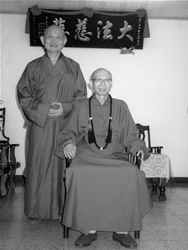
For over a year, Ven. Quandu searched for a new abbot for the temple. Several monks had contacted him or visited the land in Jinshan, but nothing came out of it. One night in the spring of 1989, Ven. Quandu chanted the Great Compassion Mantra in front of the statue of Guanuin, praying for the guidance in finding a suitable abbot. That day was March 26.
So, at the same time that Nung Chan Monastery was looking for land, the temple in Jinshan was looking for an abbot, while both sides chanted the Great Compassion Mantra, praying to the bodhisattva to fulfill their wishes. The two events were only one day apart.
On the day when the deed was signed, Ven. Quandu expressed his wish to donate his share of the land, as did one of the partners, Li Zhaonan. Therefore, DDM already had two big donors before the deed was even signed. Li was the mysterious man who predicted the land was found on that night when the Great compassion Mantra was chanted in Nung Chan Monastery.
While the temple in Jinshan was still looking for an abbot, Li visited a friend in Taichung and casually mentioned this matter. His friend directly said, "You should go to Taipei and look up Master Sheng Yen at Nung Chan Monastery!" His friend also gave him the Master's book Correct Buddhist Belief, but Li did not pay much attention and forgot about it as time went by. One day he saw a copy of it left behind in a telephone booth and felt it was no mere coincidence. He then decided to visit Nung Chan Monastery where he soon learned that they were indeed looking for land. Being involved in both parties and knowing one party was looking for an abbot while the other was looking for land, it was no wonder he announced with conviction, "Your land is found!"
Forming the Dharma Upholders Society
Start with One Desk, One Person
For the Sangha and laity alike, another wish for 1989 was the expansion of the fund raising groups.
The Dharma Upholding organizations
When the Institute of Buddhist Studies was still part of the College of Chinese Culture, there was already a Dharma Upholders Council. Supporters who donated NT$ 10,000 or more annually were designated Directors, and those who pledged up to NT$ 10,000 became Council Members. The members were mainly the supporters of CHIBC, and the Huayan Lotus Society. The first chairperson of the Dharma Upholders Council Chen Zhijin, a Thai of Chinese descent, had high expectations for advanced studies in Buddhism. He recognized the need to cultivate young Buddhist scholars: "The Sangha should teach the Dharma while the laity should support the Dharma; thus the foundation of Buddhist studies could be established", "and thus can clarify the confusion of Buddhism and Daoism in Taiwan at that time. between Buddhism and other faiths in Taiwan could be improved." The support from the laity indeed provided important foundation for the first institute of advanced Buddhist studies in Taiwan. Since Dharma Drum Mountain was founded, the same kind of support has been the firmest backup force for all of DDM's organizations.
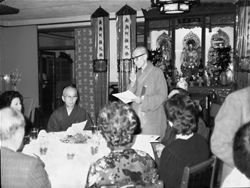
When Master Sheng Yen started leading CHIBS, there were only a few supporters, but their stories are deeply imprinted in the minds of the DDM followers. For example, Ke Yuetao, whose Dharma name is Guofu, was the first lay disciple of Master Sheng Yen after his return to Taiwan (from the U.S.). She is "big sister" to all DDM followers. Guofu was respected for her early and life-long devotion to Nung Chan Monastery. From the time she started practicing the Dharma all her thoughts were about supporting the monastery and Master Sheng Yen's ideals on education. Upon her death, her estate bequeathed all her properties, including houses, to the monastery, offering all she had to the Three Jewels and upholding the Dharma.
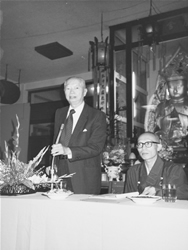
A similarly touching story concerns Weng Jiarui, founder of the Chunhui Sutra Printing Society, who later served as secrstary general of the Dharma Upholders Council of CHIBS. His Dharma work was his career and even now, cares very much about the growth of DDM. Whenever he visits, this old gentleman's favorite topic is always DDM.
There was a group of Dharma upholders, devotees of the Ci'an Monastery located in Waishuangxi, Taipei, who became supporters of Dharma Drum Mountain. They were mostly housewives and elders who saved a little bit of their daily allowance or grocery money ─ NT$ 10 or NT$ 20 a day ─ to support DDM.
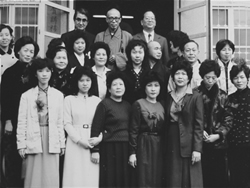 Yang Zheng Becomes Chairperson
Yang Zheng Becomes Chairperson
The founder and president of the Tai Foung Dyeing & Weaving Ltd., Yang Zheng became the second chairperson of the Dharma Upholders Council in 1987. After the Dharma Upholders Council was reorganized into the Dharma Upholders Society in 1989, he became the first president.
Yang took refuge with Master Sheng Yen in 1985 and was given the Dharma name Guowang. Being the chairperson, he had to mediate the opinions of the others and sometimes felt tired when he ran into difficulties. Master Sheng Yen always reminded him that spiritual practice dwells in both favorable and unfavorable conditions, and that serving others is sowing seeds of blessings.

Everything is hard in the beginning. During Yang's long-term dedication, he first forced himself to do the work, but later he and his colleagues encouraged each other with the attitudes of "if you can't get a bull, a horse will do" and "learn while you work." Under his leadership, the Dharma Upholders Council had quite a few accomplishments, from fundraising, to introducing the Dharma to people, organizing big fun-fairs, and so on. These activities helped assure the early success of DDM.
Dharma Upholders Society Founded
The Dharma Upholders Council for the Chung-Hwa Institute of Buddhist Studies was reorganized into the Dharma Upholders Society for DDM in 1989. Early in 1989, Shi Jianchang, the leader of the Recnitment Team of the chanting society, recommended to Master Sheng Yen that shifting the focus of fundraising from at-will donations to long-term sponsorship could generate more consistent income. Master Sheng Yen agreed and relied on him to come up with a detailed plan.
The new fundraising plan was first announced at the monthly Buddha's name recitation in March. Setting an example, Shi donated NT$ 300,000 that night to show his support for the orthodox Chinese Buddhism and advanced Buddhist studies. Unexpectedly, the members of the chanting society responded with enthusiasm. That night, many members donated NT$ 10,000, 50,000, to 100,000, totaling NT$ 1million.
The plan was announced again at the Sunday sutra study and meditation, and at the following week's Great Compassion Repentance. The devotees' passion seemed to be ignited and everyone wished to support the Dharma place wholeheartedly. A half month later, over one thousand people crowded into Nung Chan Monastery to chant the Great Compassion Mantra, praying for the land they wished for. That was an unforgettable night in the history of Dharma Drum Mountain.
On March 26, over three hundred people attended the preparatory meeting at Nung Chan Monastery to form the Dharma Upholders Society. Shi still vividly remembers that day: "Though it was a rainy day, the dinning hall was packed with people ... many did not have seats but nobody left for that reason ... you could feel strongly the intense energy from these people." All the people in that meeting became the first fundraisers. One of them is Zhou Yufen, who has been supporting Dharma Drum Mountain unreservedly ever since.
One Desk, One Clerk
Once the Dharma Upholders Society was formed, numerous administrative tasks came hand in hand with it. At Master Sheng Yen's request, Liao Jinrong, who just stepped down as president of the chanting society, began to assist president Yang zheng with the administrative work of the Dharma Upholders Society. Thus, the operation began with only one borrowed desk and one clerk. As the society flourished it acquired a second and a third desk, and eventually some office space. Full-time tmployees joined the workforce. It is worth mentioning that some of these employees later became dedicated monks and nuns. As they became more involved in the Dharma support, they deeply recognized the ideals of Dharma Drum Mountain and eventually took the vow to join the Sangha.
After one to two years of adjustment, the operation of the Dharma Upholders Society stabilized, contributing tremendously to the propagaton of the Dharma, education and construction projects. The society's initial influence was to make fundraising and education integral parts of diligent spiritual practices. While initially some members had difficulty adjusting to this, the society finally started to grow by leaps and bounds.
Forming Consensus
Gathering Momentum
After signing the deed for Jinshan in April 1989, Master Sheng Yen returned to New York. When he returned to Taiwan in midsummer, much to his surprise several fundraisers made it possible to pay off the mortgage on the land:
When I returned to Taiwan from the U.S. in July, 1989, all costs for the land had been paid, thanks to the supporters who provided interest-free loans and collateral loans, and especially who made donations, ranging from a few hundred thousand, to one million, to five million NT dollars. One supporter even donated NT$ 10million. That was not what I had expected, or even dared to imagine.
In July, 1989, Master Sheng Yen named the locale Dharma Drum Mountain.
 The Meaning of "Dharma Drum Mountain"
The Meaning of "Dharma Drum Mountain"
The term "Dharma drum" was used in the Lotus Sutra and has special meanings:
May the most honored of heavenly and human beings turn the supreme Dharma wheel, beat the great Dharma drum, blow the great Dharma conch, rain down the great Dharma rain, and deliver countless sentient beings. With utmost faith we all pray that you sound the profound and far-reaching teaching.
This stanza is a request to the Buddha, respected by humans and gods, to expound the supreme Dharma, as if waking up people of the world with a big drum and a big conch; as if nurturing the minds of the people with Dharma rain. Thus the innumerable sentient beings are delivered.
Beating the Dharma drum means enlightening the benighted and letting everyone share the benefit of the Dharma. It implies being active and diligent, achieving goals, and delivering sentient beings through Buddhadharma. On another level, the sound of the drum also implies the effect of hearing the Dharma, allowing sentient beings to resolve their vexations, anger, doubts, and arrogance. Hearing the Dharma allows them to accept its guidance, to develop equanimity of body and mind, and to deal with worldly affairs with a healthy attitude.

Dharma Drum also implies the history of publishing in DDM. Before Dharma Drum Mountain was founded, the publishing division of the Chan Meditation Center in New York had already been named Dharma Drum Publications. Early in Taipei, Dongchu Publications of Nung Chan Monastery once intended to publish a set of forty of Master Sheng Yen's books under the title The Complete Works of Master Sheng Yen.
After the land had been named Dharma Drum Mountain, the direction for its development also became clear. A committee was formed to plan for the move of CHIBS. Yang Zheng, the president of the Dharma Upholders Society, was the director, and Shi Jianchang, and Lai Yanxue were the assistant directors. They continued to work on land purchasing, planning, and requesting permission for land development. An advisory committee of architects, geologists, engineers, and artists was formed to plan the project.
At a meeting of the advisory committee, Master Sheng Yen said that a shortage of professional engineers had limited the progress of the project. After this discussion, the head of a construction company unexpectedly offered the services of one of the firm's outstanding engineers. Thus, Liu Mingshan became vice chief engineer of the DDM Engineering Office.
 Pilgrimage to the Buddha's Sacred Sites
Pilgrimage to the Buddha's Sacred Sites
While the construction project of Dharma Drum Mountain was going on, Master Sheng Yen's travel plans changed a little bit. He began planning a pilgrimage to the Buddhist holy sites. In the fall of 1989, accompanied by over eighty monastic and lay disciples, Master Sheng Yen made a fifteen-day pilgrimage to India and Nepal. Visiting the sacred sites where Buddhism originated aroused a lot of emotion in the group. Generation after generation, since its arrival in China two thousand years ago, Buddhism has adapted to Chinese culture, developing an intimacy and harmony with it. In the mid-20th century the seed of the Chinese Buddhism came across the sea to Taiwan and started a new auspicious page in its history. After visiting the Buddha's birthplace from a country full of new hopes and opportunities, the pilgrims could contemplate such questions as, "How can we make modern Buddhism match the Buddha's real intent? How can orthodox Chinese Buddhism benefit more people? What should the modern Buddhist architecture be like?"
The pilgrimage to the sacred sites was like two seven-day retreats back to back: Master Sheng Yen repeatedly reminded the group that every moment at every place should be a focal point of practice:
Let go of vexation, apply the method of practice, and enter the minds of the great masters and practitioners so that you can appreciate the compassion and merits of those who have upheld the Dharma.
One day the group visited Nalanda University in Rajagaha, once the most prosperous city in India according to the Buddhist history. Touched by the sight of this magnificent yet neglected historical site, the Master said, "The continuation of Buddha's teachings relies on only one thing: Dharma education." At the end of the pilgrimage, the mission statement of Dharma Drum Mountain was announced: "To uplift the character of humanity and build a pure land on earth." In this mission, Dharma Drum Mountain's main effort will be on education.
All Taiwan Shares Dharma Drum Mountain
After the quest for land was fulfilled in the spring of 1989, DDM's campaigns gathered momentum. The first Chung-Hwa International Conference on Buddhism was held by CHIBS at the National Central Library in January, 1990, with the topic of Buddhist Ethics and Contemporary Society.

By 1991, practice centers and liaison offices were established in Keelung, Taichung, Kaohsiung, Tainan, Xinzhu, Taoyuan, and Zhongli. By 1994 branches in Pingdong, Tucheng, Shulin, Taidong, and Anhe Branch Monastery were established, one after another. The Hong Kong Liaison Office was established in 1991 with the help of singer Ran Xiaoling. This was DDM's first overseas Dharma upholders organization.
The establishment of the practice centers was a response to Master Sheng Yen's advocacy of "every family a lotus society, every household a Chan hall." Local practitioners offered their own homes for group meditation and Buddha's name recitation, as well as for sharing and applying Buddhist teachings to everyday life.
As we enter the new century, Master Sheng Yen says that DDM is not just about building branches and practice centers but more about sharing the spirit and ideals of DDM. Those who have experienced and applied well the concepts and methods of the DDM can benefit their family, neighbors, and coworkers by sharing their experience. This is the right way to practice the ideals of DDM and to propagate its spirit.

|
|